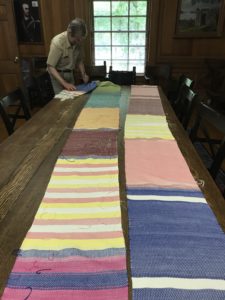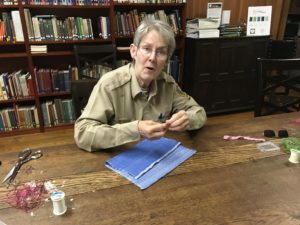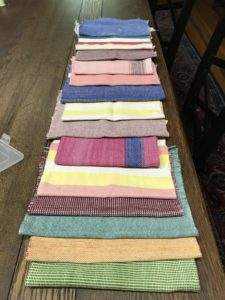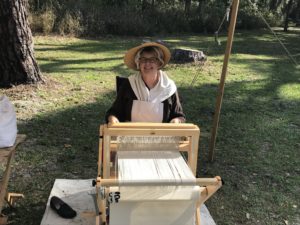
Since Fort Frederica National Monument closed on April 1, I have spent a lot of my time doing colonial weaving. The other female volunteers have also been busy weaving so we have quite the colonial weaving factory going.
First we finished the 13 cotton towels we had been working on. I think we only had one or two more to do when the park closed, so we finished the towels that week. Each towel is unique in color and weave. We took the towels off the loom in one long strip. I washed, dried, and ironed the 10 yard strip of cloth and then we laid it out on the table in the library to cut apart.
Volunteer Linda cut most of the towels apart and hemmed them. Gail and I helped a little. When we were done we had a nice pile of 13 towels, most of them 24 inches long but some a little shorter. Each of the volunteers chose a towel to keep.
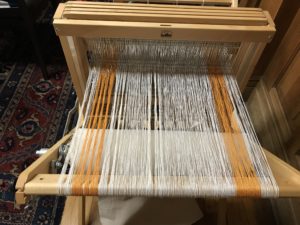
For the next project, I wanted to do something more historically appropriate and more difficult. The women at Frederica had a choice of two materials if they wanted to make their own cloth: wool and linen. They could shear the sheep for wool or grow their own flax for linen. So I wanted to do some colonial weaving in linen.
When we are demonstrating – doing living history – we have to keep the weaving patterns simple. A four row pattern is about the most we can do without losing track of where we are. But, with the loom in the library and no interruptions, we could do more complicated patterns. Although Linda headed back to Colorado, Gail, Angela, and I were all able to challenge ourselves with some linen placemats.
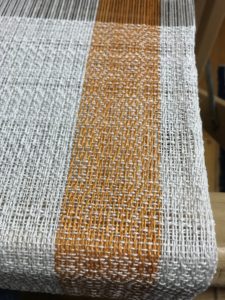
I warped the loom with 400 linen strings, 24 strings per inch. For the first time, I used unbalanced heddles, meaning that there are more heddles on some shafts and fewer on others. This helps create the more intricate patterns. Then we started our colonial weaving.
Linen is the least flexible natural fiber you can put on the loom, so it is a little challenging to weave. The yarn is stiff so you have to get the tension just right or else you end up with bumps that stick out. Sometimes we caught them in time to fix them and sometimes we didn’t.
It took me close to 40 hours to warp the loom but only took us 12 hours to weave all six placemats. Each mat is 17 inches wide and 24 inches long. Each mat also has its own pattern from a complex rosepath to a more simple zigzag.
I am very pleased with the way the mats have turned out. And I enjoyed weaving them so much it was worth all the warping time. My next project will be much simpler, but it will still be colonial weaving – this time with wool.
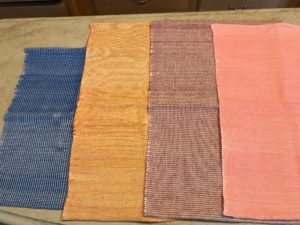 Thanks for reading all of this – I know most of you aren’t big weaving fans. To reward you for reading all the way to the bottom of the page, I am giving away four of the cotton towels we wove. You can get one by just leaving a comment below. Just tell me which color you want: blue, yellow and pink, burgundy, coral. If no one else has selected it yet, it is yours! First four commenters get one. If I don’t have your address, I will send you a message.
Thanks for reading all of this – I know most of you aren’t big weaving fans. To reward you for reading all the way to the bottom of the page, I am giving away four of the cotton towels we wove. You can get one by just leaving a comment below. Just tell me which color you want: blue, yellow and pink, burgundy, coral. If no one else has selected it yet, it is yours! First four commenters get one. If I don’t have your address, I will send you a message.

